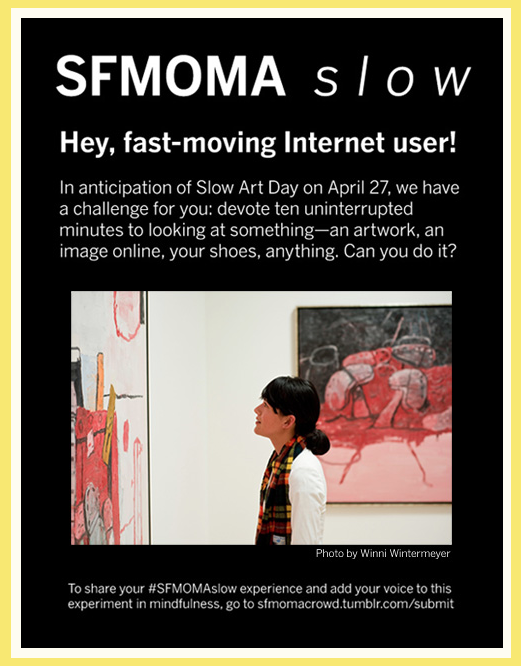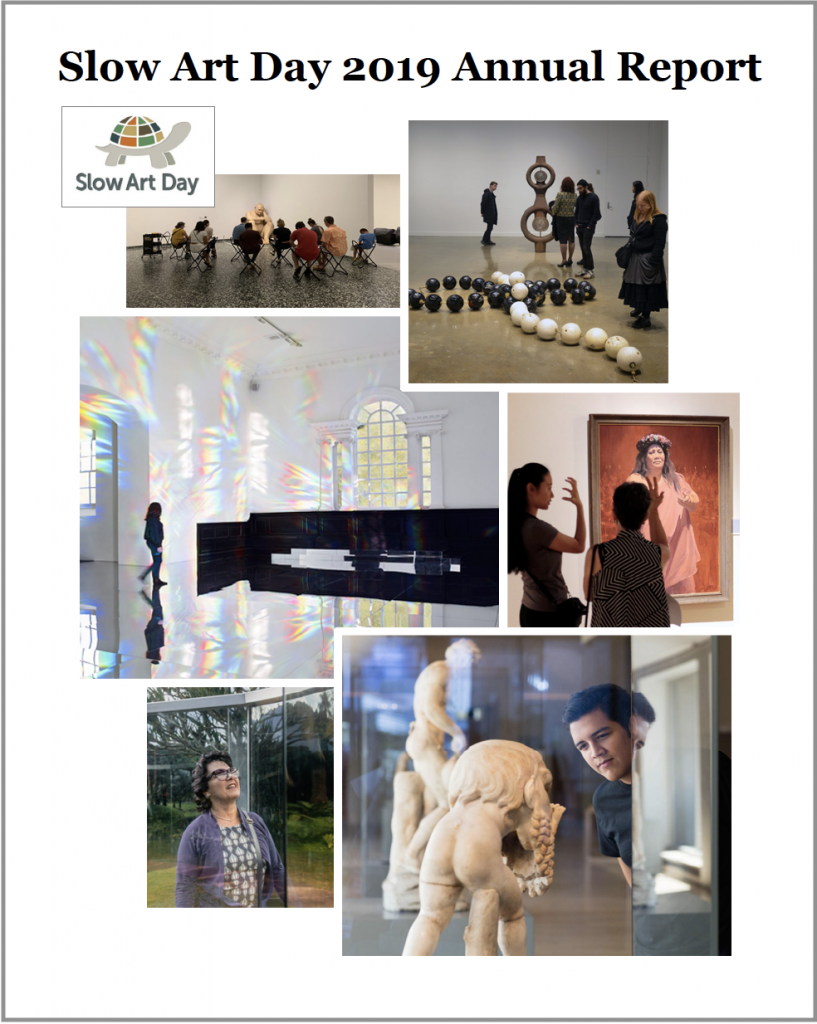[Slow Art Day Social Media Manager Alie Cline recently interviewed Willa Koerner from the San Francisco Museum of Modern Art to chat about the museum’s new Slow Art Day inspired project, SFMOMAslow.]

Slow Art Day: First, introduce yourself for us – what do you do at SFMOMA?
Willa: I’m Willa Koerner, SFMOMA’s Digital Engagement Associate. I manage SFMOMA’s social media accounts, from planning, writing, and editing posts, to documenting the goings-on of the museum, to collaborating with co-workers on digital projects and online engagement initiatives.
Slow Art Day: How did you initially hear of Slow Art Day? What sparked your interest in the project?
Willa: I heard about Slow Art Day through the social media grapevine. My interest was sparked right from the get-go, as the idea of looking/thinking slowly is fascinating when contextualized within the incredibly manic pace of the Internet.
Slow Art Day: How did the idea for SFMOMAslow initially develop, and how have you expanded on “Slow Art Day” and turned it into a larger project?
Willa: In collaboration with Suzanne Stein, SFMOMA’s Head of Community Engagement (and manager of SFMOMA’s blog, Open Space), I’ve been working on ways to get people talking with the museum in exciting, interesting ways through crowd-sourced projects hosted on a special Tumblr (SFMOMAcrowd). Hosting successful user-generated projects can be a bit difficult, and we’ve seen firsthand how challenging it can be to generate interest/response to a project prompt, no matter how interesting that prompt may seem to us within the museum. In my opinion, this is due to a simple truth: people don’t want to spend their valuable time creating something unless there is an explicit reason to participate, or a reward. Knowing this, we wanted to pursue a prompt that would ultimately lead to a rewarding and satisfying experience for all types of participants. The Slow Art Day concept fit this desire perfectly, so we decided to create a whole slew of programming, tweaking the idea so that it would be interesting to those who can visit the gallery in person as well as those who may prefer to participate remotely.
Slow Art Day: What has the response been like?
Willa: People have seemed genuinely excited about (and possibly thankful for) the idea of #SFMOMAslow/Slow Art Day. It is an invitation to relax and appreciate life, isn’t it? In terms of participation with the crowd-sourced project more people prefer to watch than to join in, I think, but those folks who have taken the leap and participated seem to have truly valued the experience. One person ended her post with, “ I feel as if [looking slowly] sharpens perception because there is a very deep meditative quality to it! Thank you!” That made me smile.
Slow Art Day: How do you think “slow” art fits into our fast-paced, modern world?
Willa: I see Slow Art Day and the challenge to truly look slowly as a bit of an intervention. People move so quickly and rush through experiences that would be much more magical when taken in at a slower, more contemplative pace. I wish I didn’t, but I too am guilty of senselessly rushing through all sorts of experiences — it’s the curse of having endless access to information and ideas, and seemingly thing after thing to rush off to. We joke about “FOMO” [Editor’s note: “fear of missing out”] but it’s a real and problematic plague for our generation! We want to see it all, do it all, and share it all. Slow looking is a way that we can re-learn how to think critically and be patient with ourselves and our minds.
Slow Art Day: We couldn’t agree more! Finally, what are you most looking forward to on Slow Art Day itself?
Willa: I’m closing my eyes and imagining Slow Art Day at SFMOMA… in my mind, I see myself smiling a lot and enjoying a rewarding day filled with compelling art, perceptive people, and intriguing conversation. Stay tuned for my tweets on that Saturday — I’ll be using the #SFMOMAslow hash tag!
And, before I sign off, I want to extend huge thanks to Alie, my interviewer, and everyone who volunteers to help spread the ideas of Slow Art Day to people around the world! You guys are doing a terrific job.
Slow Art Day: Thanks, Willa! We very much appreciate all the hard work you are putting in to spreading the idea of slow art as well.
[If you’re in the San Francisco area, make sure to check out SFMOMA’s Slow Art Day event and learn more about SFMOMAslow through their tumblr, SFMOMAcrowd]


